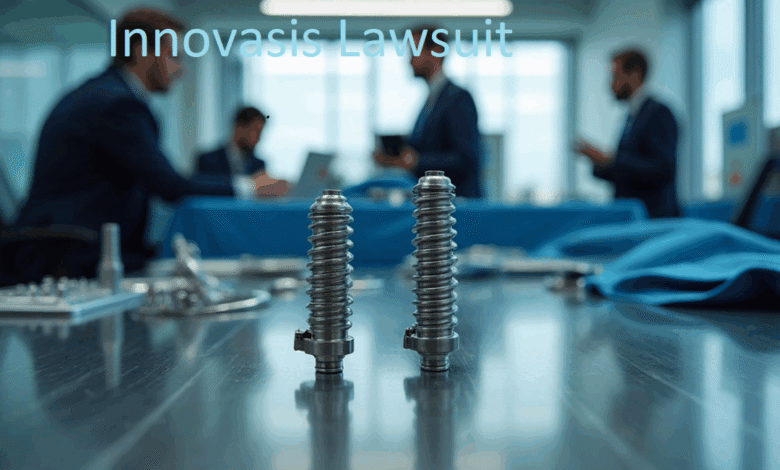Innovasis Lawsuit: What You Need to Know

Introduction to the Innovasis Lawsuit
Legal disputes in the medical device industry are nothing new, but when a company like Innovasis Lawsuit, known for its spinal implant technologies, finds itself in the middle of a lawsuit, it naturally attracts attention. Innovasis has been a recognizable name in the healthcare sector, especially among surgeons and hospitals that rely on advanced spinal solutions. However, a lawsuit involving the company often sparks curiosity and raises questions about the reasons behind the legal action.
The Innovasis lawsuit is not just about one company. It reflects broader themes within the medical device industry, such as patient safety, regulatory compliance, and corporate responsibility. Innovasis Lawsuit In an era where innovation is essential for progress, the fine line between rapid product development and ensuring safety often becomes the center of legal scrutiny.
Understanding this lawsuit requires more than just headlines. Innovasis Lawsuit It calls for an exploration of Innovasis’s background, the circumstances leading to the legal battle, and the potential impact it could have on patients, the healthcare industry, and even the company’s long-term reputation.
Background of Innovasis as a Company

Innovasis Lawsuit is a medical technology company that focuses primarily on spinal implant solutions. Innovasis Lawsuit Based in Utah, it has spent years building a name for itself as a trusted provider of devices that aid in spinal fusion surgeries and other orthopedic procedures. Their mission has always been to improve patient outcomes through innovation, and for the most part, they have enjoyed credibility among healthcare professionals.
Spinal surgeries are no small matter. Innovasis Lawsuit They require precise, reliable, and safe implants, as patients depend on these devices for improved mobility and long-term health. Innovasis has contributed significantly to this field by developing products aimed at both effectiveness and affordability. However, with such high stakes, even minor concerns around safety or compliance can lead to major legal consequences.
The company operates in a highly competitive industry, where giants like Medtronic and Stryker dominate the market. For Innovasis, carving out space in this environment has meant walking the tightrope between aggressive growth and strict regulatory oversight. Innovasis Lawsuitc This lawsuit demonstrates just how fragile that balance can be when questions of safety and compliance come into play.
What Triggered the Innovasis Lawsuit?
At the core of the Innovasis lawsuit are allegations that the company may have engaged in questionable practices involving its medical devices. Innovasis Lawsuit While the specifics vary depending on the legal filings, cases like this often involve claims related to product safety, marketing practices, or compliance with FDA regulations.
One of the common triggers for lawsuits in the medical device industry is the allegation that a product did not perform as advertised, or worse, caused harm to patients. Innovasis Lawsuit With spinal implants, even minor design flaws can lead to severe complications, such as chronic pain, nerve damage, or the need for additional surgeries. These outcomes often bring patients, regulators, or competitors to court.
Another frequent source of legal trouble lies in marketing practices. If a company is accused of promoting devices for unapproved uses or making claims that go beyond what regulators have authorized, it can lead to both civil and criminal legal challenges. Whether Innovasis is accused of such issues or something entirely different, the lawsuit highlights the scrutiny medical device companies face daily.
Patient Safety Concerns and Legal Implications
For patients, lawsuits like this hit close to home. Spinal surgeries already carry risks, and the idea that a device may not be as safe as expected can create anxiety for those who rely on these technologies. When a lawsuit emerges, it raises a red flag for patients, doctors, and hospitals alike, forcing them to reconsider their trust in the product or brand.
Legal actions involving patient safety often revolve around product liability. This means the plaintiffs must show that the device was defective in its design, manufacturing, or labeling. Even if a product works well in most cases, rare but severe complications can lead to high-profile lawsuits. For companies like Innovasis, defending against these claims is not just about winning in court—it’s about preserving the trust of the medical community.
The implications extend beyond the courtroom. If the lawsuit gains significant media attention, it may affect Innovasis’s reputation, sales, and partnerships. Hospitals and surgeons may hesitate to use their products until the matter is resolved, which could hurt the company’s bottom line and slow down its growth in an already competitive industry.
Regulatory Oversight in the Medical Device Industry
The Innovasis lawsuit also underscores the importance of regulatory compliance. The U.S. Food and Drug Administration (FDA) plays a critical role in monitoring medical devices, ensuring they meet safety standards before being approved for use. However, approval is not the end of the story. Companies must continuously monitor the performance of their products, report adverse events, and comply with strict manufacturing standards.
When companies fail to follow these regulations closely, they open themselves up to legal risk. Allegations of non-compliance, whether valid or not, can draw significant attention from both regulators and litigators. The medical device sector is one of the most tightly monitored industries, yet it continues to produce some of the most innovative technologies. This constant tension between innovation and regulation sets the stage for lawsuits like the one Innovasis is facing.
It’s also worth noting that regulatory oversight doesn’t only come from the FDA. State regulators, international authorities, and even private watchdog organizations often play a role in monitoring compliance. This web of oversight makes it even more challenging for companies to ensure they’re meeting every requirement.
How This Lawsuit Could Affect the Medical Community
Lawsuits against medical device companies don’t just affect the corporations—they ripple outward into the broader medical community. For surgeons, a lawsuit like Innovasis’s may force them to reconsider whether to continue using certain devices. Even if the products are ultimately cleared of wrongdoing, the temporary shadow of doubt can alter surgical decisions and hospital purchasing agreements.
For patients, the lawsuit may lead to increased caution or hesitation in undergoing procedures that involve Innovasis devices. In some cases, patients may request alternative products, even if Innovasis devices remain available and approved for use. The psychological impact of a lawsuit can be just as influential as the actual legal outcome.
Additionally, lawsuits often drive broader conversations about patient rights and corporate accountability. If Innovasis is found liable, it may lead to stricter guidelines for the entire industry, potentially raising the bar for safety and transparency. On the other hand, if the company successfully defends itself, it could set a precedent that shapes how future lawsuits against medical device manufacturers are approached.
Innovasis’s Response and Defense Strategy
Like most companies facing legal challenges, Innovasis is likely to present a strong defense. This typically includes emphasizing the safety and effectiveness of their products, showcasing data from clinical trials, and pointing out compliance with FDA regulations. The company may also highlight testimonials from surgeons and patients who have benefited from their devices.
In many cases, companies argue that complications are rare and fall within the accepted risks of medical procedures. Innovasis may take a similar stance, suggesting that while no medical device is completely free of risks, their products meet all necessary safety standards. This line of defense aims to reassure both the court and the public that the company has acted responsibly.
Beyond legal strategies, Innovasis may also focus on reputation management. By engaging with healthcare providers, issuing statements of transparency, and doubling down on patient safety initiatives, the company could attempt to soften the blow of negative publicity. In lawsuits involving healthcare, public perception is often just as important as the actual verdict.
The Bigger Picture: Lessons from the Innovasis Lawsuit
When we step back, the Innovasis lawsuit is more than just a legal battle. It reflects the ongoing challenges faced by companies in balancing innovation with accountability. The healthcare industry thrives on innovation, but when patients’ lives are at stake, there’s zero room for error. Lawsuits like this remind us that oversight and responsibility must grow alongside technological progress.
For other medical device companies, the Innovasis lawsuit serves as a cautionary tale. It highlights the importance of robust quality control, transparent marketing practices, and continuous compliance with regulatory standards. These elements are not optional—they are essential for long-term survival in a high-stakes industry.
Ultimately, the outcome of this lawsuit will have implications not just for Innovasis but for the entire spinal implant sector. Whether it results in stricter regulations, improved corporate practices, or simply a reminder of the risks involved, it will leave a mark on how companies approach both innovation and accountability in the future.
Conclusion
The Innovasis lawsuit shines a light on the delicate balance between innovation, regulation, and patient safety in the medical device industry. While the specific allegations remain to be fully resolved, the case serves as a reminder of the responsibilities that come with developing technologies that directly impact human lives.
For patients, it raises important questions about the trustworthiness of medical devices. For the medical community, it’s a prompt to carefully evaluate the tools they use. And for Innovasis, it’s an opportunity—albeit a difficult one—to prove its commitment to safety, compliance, and integrity.
No matter how the case unfolds, the lawsuit is part of a bigger conversation about how healthcare companies can innovate responsibly while ensuring that patient well-being always comes first.



